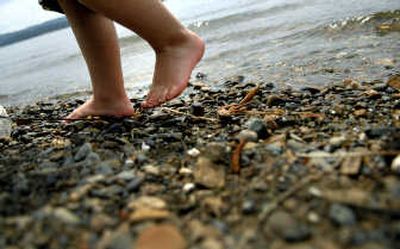Plan aims to protect lake

At the bottom of Lake Coeur d’Alene, divers frequently encounter iridescent colors in the mud – glowing reds and oranges that point to the presence of iron oxide.
These are the lake’s toxic hot spots. A century of mining pollution from Idaho’s Silver Valley bonded to the iron oxide and washed into the lake, creating deposits of lead, zinc, cadmium and arsenic.
Lake Coeur d’Alene’s sediments hold up to 83 million tons of heavy metals. According to scientists, that’s the best place to keep the metals.
“Our goal is to keep those metals at the bottom of the lake,” said Glen Rothrock, lake management coordinator for Idaho’s Department of Environmental Quality. “We believe the best way to do that is to maintain good oxygen levels” in the water.
On Tuesday, the DEQ and the Coeur d’Alene Tribe unveiled a draft plan for protecting the lake’s water quality. The plan is a long-term effort that will require support from local governments, developers and residents, officials said.
“It’s a forever plan,” said Phil Cernera, the tribe’s lake management director. “We’ll need it as long as the lake is here, as long as people are here and as long as the metals are here.”
The lake management plan is a companion to a $350 million Superfund cleanup of mining waste in the Coeur d’Alene basin, but it relies on local, not federal, efforts.
“No one really wanted the stigma of Superfund hanging over the lake for 50 years,” Cernera said.
The DEQ and the tribe spent two years hammering out the plan with the help of a mediator.
Lake Coeur d’Alene’s water quality has generally improved since the 1970s, when upstream mining companies stopped dumping tailings into the Coeur d’Alene River. Oxygenated water caps the metals in the lake sediments, preventing them from turning into a toxic solution that could mix with lake water. But the chemical process that creates the cap is disrupted when dissolved oxygen levels plummet.
On Tuesday, the tribe and DEQ outlined ways to keep phosphorus, nitrogen and other algae-feeding nutrients out of the lake. Septic tanks, fertilizers, erosion and stormwater runoff contribute to the lake’s nutrient levels, encouraging algae and other plant growth. As the plants die and decay, they suck oxygen out of the water.
Low oxygen levels are already a concern in the more shallow, southern end of Lake Coeur d’Alene, the DEQ’s Rothrock said. Water problems in the lake’s southern end could spread north, where most of the metals are, he said.
Cernera said state, local and federal governments already have development regulations to keep nutrients out of Lake Coeur d’Alene. But many agencies lack enough staff to enforce their rules. Lobbying for more inspectors is part of the plan, he said.
About 35 people attended a public meeting on the plan Tuesday evening. Residents’ support is crucial for securing state, federal, local and tribal financing for the plan, officials said.
The plan calls for spending as much as $1.5 million annually for the first five years on monitoring, sampling and outreach. Part of the money would fund a “Lake Stewardship” office in downtown Coeur d’Alene that would teach residents and developers how to protect the lake. Additional money would be needed for bigger projects, such as replacing faulty septic systems with sewers.
Protecting the lake requires a community effort, officials said.
The DEQ’s Gwen Fransen spent her childhood vacations at a family cabin on Diamond Lake north of Spokane. At the time, she thought nothing of bathing her dog in the lake or scrubbing down a boat and rinsing off the suds in the water.
“We had lawn down to the water’s edge. My dad would be out there with the Weed and Feed,” said Fransen, now a lake scientist.
Each of those small actions degrades water quality, she said. “We just don’t do those things anymore.”
North Idaho resident Joy Cassidy figures her ancestors are partly to blame for the metals in Lake Coeur d’Alene. Her grandfather worked for Hecla Mining Co. “He made a fortune,” she said.
Now, the area’s natural beauty is the commodity bringing people to North Idaho, and the booming population poses new threats to the lake, Cassidy said.
“That’s a lot of people, a lot of boats and a lot of pollution,” she said. “Everybody wants their dream home. It’s all about me.”
Regular monitoring is the backbone of the plan. If water quality in Lake Coeur d’Alene improves, “then we’re golden,” said Fransen.
If not, developers and landowners could face stringent regulations.
Rothrock pointed to Lake Tahoe, where cutting down a tree on waterfront property requires a lengthy permit.
“We don’t want to go where Lake Tahoe is,” he said.